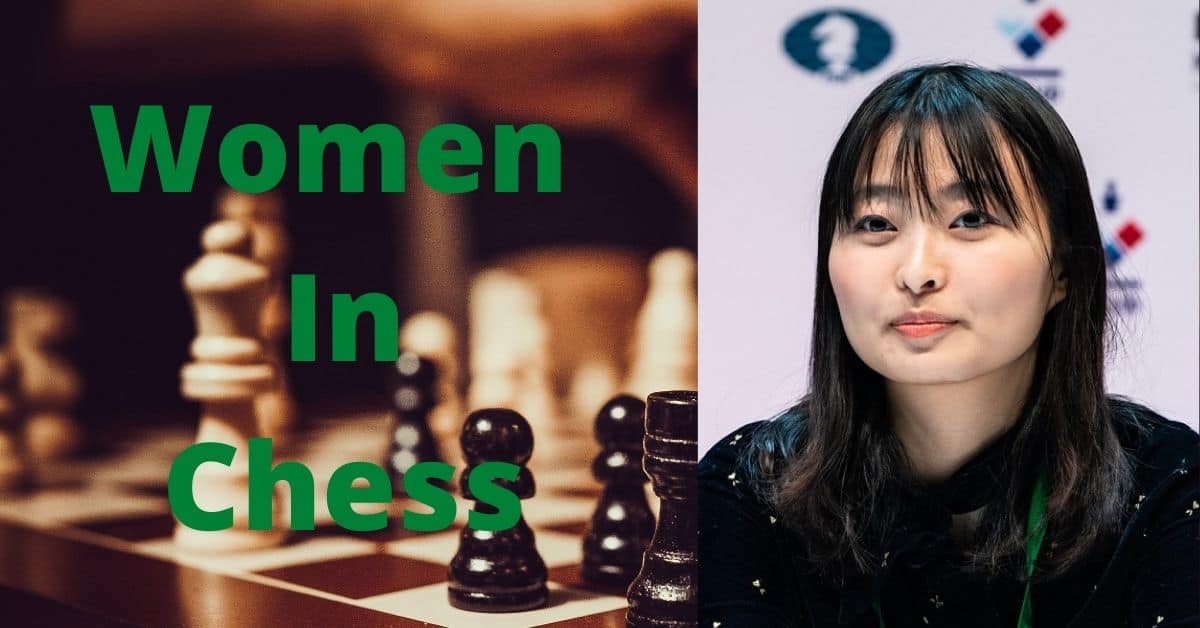Like any other sport or game, chess has its rules and etiquettes for players to follow. So what are the rules of chess?
The laws of chess, or the rules of the game, refer to certain rules that determine how one should play the game. The rules of chess can be divided into:
- Competition rules
- rules of how the game should be played(e.g moving the pieces)
While the origins of chess are somewhat vague, the modern rules of chess first originated in the Middle Ages. The rules have been continuously modified. In previous centuries, rules also varied from place to place. The world chess organization has now set universal standardized rules (which are slightly modified from national ones).
Fast chess, chess variants, online chess, and correspondence chess have their own slight rule variations. The most basic rule is that chess is played between two people. Each player has sixteen pieces (of six different types). The pieces are arrayed on the board. The ultimate goal of each player is to “checkmate” his/her opponent. This means the opponent’s king is put into a situation in which capture is unavoidable.

A chess game does not necessarily end with a “checkmate.” Often, players see their defeat coming and believe they will lose the game. Therefore, they voluntarily resign. In addition, sometimes, a game may end in a draw, called a “stalemate.”
The players take alternating turns. A player is entitled to move one piece each move. If the piece you move ends on a box occupied by the opponent’s piece, this means you have captured their piece. It is then permanently removed from the game.
Once you can make a move that leads to the capture of your opponent’s king, you win. This is known as the “checkmate stage,” in which an opponent has no other move left to save his/her king. It is considered illegal to make any move that easily exposes your king to immediate capture. You cannot move into “check.” It is also illegal to attempt to force a draw or avoid defeat simply by repeating the same moves. In particular, one cannot make repeated checks.
The responsibility lies on the attacker to use other moves to capture the king. Apart from basic movements of chess pieces, the rules of the game also govern time control, player ethics, and conduct, recording moves with the appropriate chess notation, resolving any irregularities which may occur, and using the correct equipment.
Starting Position Rules of Chess
Chess is played on a checkered board with 64 squares and 32 pieces:
| Chess Piece Name | Symbol | Quantity |
| King |  | 1 |
| Queen |  | 1 |
| Rook |  | 2 |
| Bishop |  | 2 |
| Knight |  | 2 |
| Pawn |  | 8 |
The pieces start in this position:
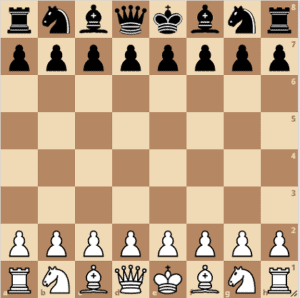
The first rule of chess is that each player MUST make a move on each turn. They can’t simply “skip” their turn. White goes first. On each turn, a piece is moved from one square to another. If it lands where the opponent has a piece, then it captures that piece and removes it from the board.
There are six kinds of pieces and each has its own way of moving:
- The King moves one square in any direction, straight or diagonally.
- The Queen moves in any direction in a straight line as many squares as she want.
- The Rook moves straight (Backwards, forwards or sideways) as many squares as he wants.
- The Bishop moves diagonally (along squares of the same color) as far as he wants.
- The Knight moves like an “L”, going two squares in one direction then one to the side. He always lands on a square of different color then the one he left, but not a square next to him. A Knight is the only piece that is allowed to hop over other pieces
- The Pawn goes one square forward when it moves normally, and one square diagonally ahead when it captures.
Diagram showing how the pieces move
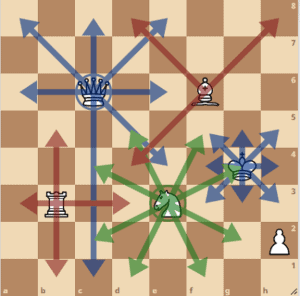
The object of the game is to capture the other player’s King
Special Pawn Rules
Double Leap
The normal move for a pawn is one square at a time, but all pawns are allowed to go forward two squares the first time that they move. As long as a pawn has not moved before, it has the choice of going one or two squares. Pawns are never allowed to capture two squares diagonally.
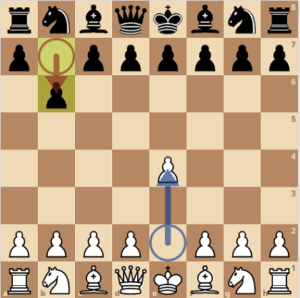
Pawn Promotion
Pawns only go forward. All of the other pieces can go backward. When a pawn reaches the last rank, it is promoted into another piece. The pawn may become a Queen, Rook, Bishop, or Knight, but not a King. It is possible to have more than one Queen, The new piece replaces the pawn on the “promotion square”.
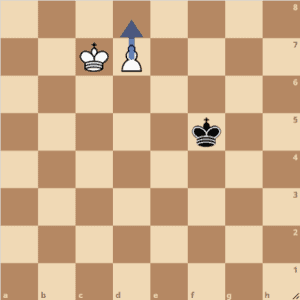
Learn more about pawn promotion
En Passant
If a pawn makes a double leap and passes over a square where it could be taken by an opposing pawn, then the opposing pawn can capture it as if the pawn just moved one square, but only on the very next move.
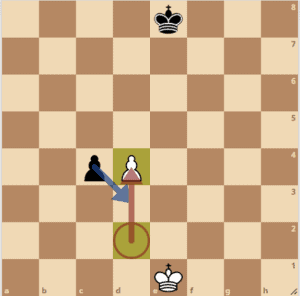
Chess Moves
If you are looking for more in-depth courses on piece movement or any other chess tactic, be sure to check out our interactive chess courses!
Queens, Rooks, and Bishops move along open lines as many squares as they like. But they cannot jump over other pieces. Any pieces standing in the way, their own or the opponent’s, block them from moving. In the diagram, the Rook has 7 possible moves, which include taking the black pawn. It may not go to the square behind the pawn or take the Queen.

Knights cannot be blocked. They can hop over any pieces that stand between them and the square that they are moving to. Knights do not capture a piece when they jump over it.
Rules For Capturing Chess Pieces
A piece is captured when the opponent moves a piece to the same square. Captured pieces a removed from the board and are out of the game. There is no requirement to take a piece when capture is possible. Players may not take their own pieces.
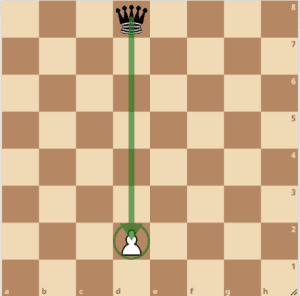
Here, the black queen may capture the white pawn on d2
The pawn is the only piece that captures differently than it moves. A pawn can advance to the square in front of it when that square is empty, but not if the other player has a piece there. A Pawn can capture diagonally forward when the opponent has a piece there, but cannot go there if the square is empty. In the diagram, the pieces have these options:
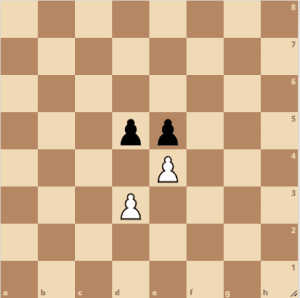
- White pawn on the left can advance but not take
- White pawn on the right can take but not advance.
- Black pawn on the left can either advance or take.
- Black pawn on the right can neither advance nor take.
Rules Of Check
A King is in check when the opponent can capture him on the next turn. A King cannot be left in check. He must be saved immediately with a move that gets him out of check. It is illegal for players to leave their own King in check or to make a move that places him in check. The game cannot be won by capturing a King that moves into check or fails to get out of check. In friendly games, it is polite to say “check” when the King is checked, but there is no rule about this.
Getting Out Of Check
There are three ways to get out of check:
- Move the King to a safe square
- Capture the piece that gives check
- Block the line between the King and the checking piece
A King may capture a piece if he is not in check after the capture. A King may not move next to the other King.
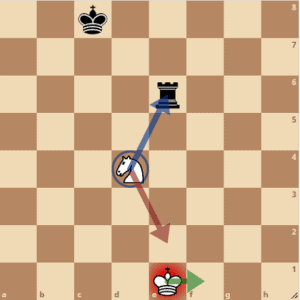
Rules Of Checkmate
When a King is in check and there is no way to get out of it, he is “checkmated”. The King cannot escape his fate and the game is over. The actual capture of the King never takes place on the chessboard, even though that is the object of the game! In this example, the white King is in check from one of the Rooks.
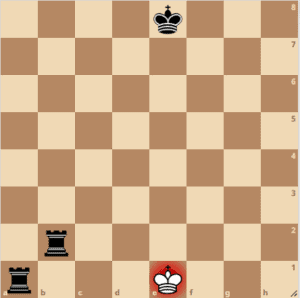
There is no move to block the check or to capture the checking Rook. And there is no safe place to run. All five of the squares around the white King are attacked by the Rooks. Checkmate Black wins!
Chess Rules For Castling
Once a game, each player may make a special move called castling. It is the only time in chess when two pieces can move in the same turn. Castling is done with a King and a Rook and can only be played after the pieces between them are out of the way. First, the King moves two squares to the right or left, and then the Rook from that corner “hops over” to the square the king crossed.
When the King goes toward the nearer corner, he castles short (Kingside). The other way is called long or queenside.
Castling is not allowed when:
- The King or Rook have moved before
- The King is in check
- The King would move through check
The third point means that castling is prevented if the opponent is attacking the square that the King must cross over.
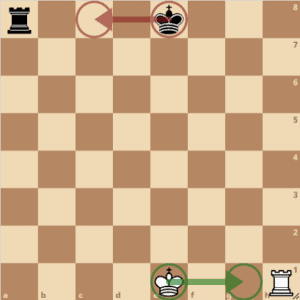
Diagram showing white castling kingside while black castles queenside
Rules Of A Draw
Not every game of chess has a winner. Ties are called draws. There are five ways that a chess game can be drawn:
1. Stalemate: The game is drawn if a player has no legal moves on their turn. A stalemate is different from a checkmate because a stalemated King is not in check.
2. No Mating Material: A game is drawn if there are not enough pieces for checkmate. There are three situations where checkmate is impossible:
- King against King and Bishop
- King against King and Knight
- King and Bishop against King and Bishop (If Bishops are on the same colored square)
3. Draw By Agreement: Players may agree to call a game a draw. The correct moment to offer a draw is just after making a move. Once the draw offer is made, it is up to the opponent to decide whether or not to accept. The offer cannot be taken back. If the opponent agrees to the draw, the game is over. A draw offer is refused by saying no or simply by making a move.
Draw offers are only good for one turn. Once the opponent has made a move, the offer is canceled and the game goes on. If a player offers a draw before making a move, the opponent may wait until after the player moves to decide whether to accept. If a player offers a draw while it is the opponent’s turn, the offer is still valid and may be accepted.
4. Fifty Move Rule: Each player has made 50 moves without advancing a pawn or capturing a piece.
5. Threefold Repetition: The position has been reached three times.
Competition Chess Rules
Basic competition rules are the same as in a normal chess game. You must use only one hand to move a piece, and you must take it off as soon as you have made the appropriate move. Once you have moved a piece, it is illegal to reverse a move. If a player castles, he or she must first move the king with one hand and then move the rook with the same hand.
Once a pawn is promoted and pieces are moved accordingly, players are not allowed to touch those pieces again to reverse the moves. However, if the promotion is not final, then a new piece can make any valid move. In a game, the player who successfully checkmates an opponent’s king will be declared the winner, and the game ends. The player has to ensure that all the moves he or she makes are valid and legal. However, if an opponent believes that he or she will ultimately lose the match, they have permission to resign and let the other player win.
The game is a draw when a player has no other legal moves left and his/her king is not in check. At this stage, the game will reach a “stalemate.” This will immediately end the game, as long as the move that leads to the stalemate was legal.
The game also ends in a draw when the time comes that neither player can checkmate the opponent’s king, nor can he or she make further legal moves. At such a point, the game has reached a “dead position.” This will end the game; neither can claim victory.
The game also ends in a draw if pieces have been moved to an identical position on the board at least three times. Another draw situation results if both players have made fifty moves consecutively without moving any pawns and without capturing any pieces.
Let’s look further at some basic competition rules you will encounter.
Fifty-Move Rule
A draw may be claimed by either player if fifty moves in a row are made without a capture or a pawn move. This means 50 moves for each player(100 total). Every time a pawn is moved or a piece is captured, the counter goes back to zero.
A player may only claim the draw on their turn, either after the opponent has just made the 100th move or before the player is about to make to 100th move. This rule usually only applies late in the game when one of the players is trying to checkmate their opponent’s lone king.
Related Post: Fifty-move rule
Three Time Repetition
A draw may be claimed either by either player if exactly the same position is reached three times. For a position to be claimed as the “same”, the same kind of pieces must be on the same squares with the same possible moves (including castling and en passant). It must also be the same player’s turn. The position does not have to repeat three times in a row, and it does not have to arise from repeating the same moves.
A player may only claim the draw on their own turn and before they make the move. The draw may be claimed for the current position or for the position that will appear after their intended move.
Perpetual Check
Perpetual check is another way for a game to end in a draw. It happens when one player keeps checking the opponent’s King over and over, but without giving checkmate. There is no special rule about this kind of draw because eventually the game is drawn by either three-time repetition or the 50 move rule.
Other Chess Rules

Rules for setting up the chess board
The board is placed so both players have a light square in their right-hand corner. (Pieces are called white or black. Squares are referred to as light or dark.) The queen begins the game on their own color. White queen on a light square, black queen on a dark square.
Colors
Players should decide randomly who has the white and black pieces. A common method is known as the “pawn thing” is for one player to conceal a pawn in each hand, one white and one black. The opponent chooses a hand and gets that color. If more than one game is played, colors are switched each time.
Resignation
A player may give up at any time by saying, “I resign”. This ends the game and the opponent wins.
Completed Move
A move is completed and cannot be taken back once a player lets go of the piece
Illegal Moves
If an illegal move is made, the player must take it back and make a legal move instead. There is no penalty. If it is noticed that an illegal move happened earlier in the game, the players should go back to the position where it occurred and continue the game from there. If this is not possible or the players cannot agree on the position, they should return to the last legal position that they do agree on, restarting the entire game if necessary.
Behavior
Players are not allowed to distract or annoy their opponent in any way. This includes talking or repeatedly offering a draw.
Help
Players may not consult books, notes, or computers during the game. And, they may not receive advice from other persons, whether they ask for it or not.
Touch Move Rule
If a player touches one of their own pieces, they must move it. If they touch one of the opponent’s pieces, they must capture it. To straighten up the pieces on their squares without being required to move them, a player should first say, I adjust.
If a player touches a piece that cannot legally move, there is no penalty. They simply move another piece. There is also no penalty for touching an opponent’s piece that cannot be legally captured. Touch move is an optional rule, usually in serious games. Players should agree before the game whether they are playing “touch move” or not.
Related Post: Touch Move rule
Chess Clocks
There are many special rules for games where chess clocks are used. Some of the rules only apply to certain time limits (standard, active, or blitz). Tournament regulations concerning clocks and time limits are complicated and they often change.
Only a few basic rules are given here :
A player loses the game if they do not make the required number of moves within the time limit. The exception is when the opponent only has a King remaining. The game is drawn in that case. A player may never win on time with just a King.
(The exact rule is: A game is drawn when a player runs out of time and the opponent cannot possibly give checkmate, even with the help of bad moves.)
The right way to offer a draw is:
- Make the move
- Offer the draw
- Press the clock
Players must press the button on the clock with the same hand they use to make their move. They may not pick up the clock or punch the button hard. The clock may only be stopped if a tournament director (referee) is not present and the player is going to find one.
Final Verdict – Rules Of Chess
Knowing the basic rules of chess will take you a long way. Chess rules were made to create fair play and proper sportsmanship. Without them, there would be ongoing chaos and calamity.
In competitions, it is customary to shake hands with your opponent, before and after the game. Being courteous and playing quietly is always a good idea. Try never to distract other players. When there’s a dispute, stay calm and tell the officials what happened. They will do their best to be fair. If a decision goes against you, accept it gracefully. Don’t forget it’s only a game.
Chess is supposed to be fun for both players. The final result is not the most important thing. Win or lose, be a good sport:)
Related Post: How to win at chess?





